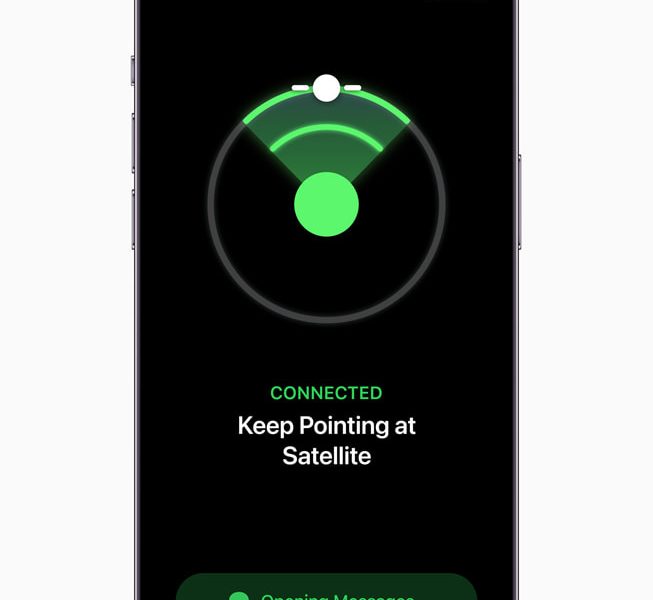Apple announces iPhone 14 lineup with Emergency SOS via Satellite, Crash Detection featuresApple announces iPhone 14 lineup with Emergency SOS via Satellite, Crash Detection features
September 8, 2022

Apple yesterday announced updates to its device portfolio with new capabilities, including two that are designed to enhance the ability for customers to get help in dire circumstances: Emergency SoS via Satellite and Crash Detection.
Available with all iPhone 14 models, Emergency SOS via Satellite lets users contact emergency services via text, even when the phone is outside the coverage footprint of a cellular carrier or Wi-Fi hotspot. Expected to launch in November, Emergency SOS leverages the Globalstar network that operates on licensed 2.4 GHz spectrum known as Band 53/n53, according to an SEC filing that Globalstar released yesterday.
Connecting an iPhone that does not have an external antenna to a satellite that is hundreds of miles above the earth’s surface is a “technical challenge,” but Apple has designed a way to make it work, if there is a “clear view of the sky” and “the phone is directly pointing at a satellite,” Ashley Williams of Apple said during yesterday’s event.
Tracking the Globalstar satellites is done with an application that is available on iPhone 14, Williams said.
“Satellites fly too high to be seen by the human eye, so we created a unique user experience that shows you where to point your phone to establish a connection and stay connected as the satellite moves,” Williams said during the event. “This way, no bulky antenna is needed [to connect to the satellite].
“Once connected, you need to send and receive enough information to get emergency help. Standard messaging protocols are not designed for satellite’s limited bandwidth, so we created a custom, short-text compression algorithm to reduce the average size of message by a factor of three.”
With a clear view of the sky, a user can transmit an Emergency SOS via Satellite text in less than 15 seconds, but a transmission could “take a few minutes” if light foliage is encumbering the link between the iPhone 14 and a satellite, according to Williams.
Given the bandwidth limitations and connectivity challenges associated with Emergency SOS via Satellite, Apple has developed an application that is designed to streamline the text communications between the user and emergency-services entity, Williams said.
“We worked with emergency experts to surface the questions they’re most likely to ask, and we provided the most common responses for you to choose from, with just a few taps,” Williams said. “With fewer messages to write and send, you can get help quicker. After a message is relayed to a ground station, it needs to reach the right emergency-service provider. If that emergency-service provider accepts text messages, we will connect you to them directly.
“If they only accept voice calls, we have set up relay centers staffed with highly trained emergency specialists ready to get your text and call an emergency-service provider on your behalf.”
This iPhone 14 satellite capability can be leveraged in non-emergency scenarios, as well.
“This breakthrough service can also be used in more casual, less dire circumstances,” Williams said. “So, if you’re out on a long hike, you can use the Find My app to share your location manually via satellite. This lets your loved ones know where you are without even sending a message.”
Emergency SOS via Satellite and other iPhone 14 satellite services are not the first satellite-direct-to-phone service to be announced, but they will be the first such services to be offered commercially at scale. It also is satellite-direct-to-phone offering that plans to leverage existing satellite spectrum, instead of utilizing spectrum licensed to a commercial wireless carrier.
T-Mobile and SpaceX recently announced joint plans to provide satellite-to-phone text, voice and some limited data in the future on T-Mobile’s 1.9 GHz airwaves. Lynk Global and AST SpaceMobile also have announced plans to build low-earth-orbit (LEO) satellite constellations and partner with cellular carriers to address outdoor coverage gaps initially via text and voice, but eventually also providing broadband services.
Lynk Global and AST SpaceMobile plan to leverage carrier-partner spectrum below 1 GHz—airwaves that have much greater signal-propagation characteristics that the 2.4 GHz that Apple will use for its service—and act as “LTE towers in space” to augment terrestrial-network coverage. SpaceX plans to provide the same capability to T-Mobile on the 1.9 GHz PCS spectrum.
Officials for Lynk, AST SpaceMobile and SpaceX have stated that users will be able to use their phones in a normal manner, as opposed to needing to point them at satellites. However, none of those companies plan to offer satellite-direct-to-phone service in the U.S. until at least next year, and all are awaiting regulatory approvals from the FCC to pursue their business plans.
In addition to the Emergency SOS via Satellite offering, Apple announced Crash Detection, a new feature on both iPhone 14 and Apple Watch that is designed to help users contact emergency-services agencies after a car crash.
“With a new dual-core accelerometer capable of detecting G-force measurements of up to 256Gs and a new high dynamic range gyroscope, Crash Detection on iPhone can now detect a severe car crash and automatically dial emergency services when a user is unconscious or unable to reach their iPhone,” according to an Apple press release. “These capabilities build on existing components, like the barometer, which can now detect cabin pressure changes, the GPS for additional input for speed changes, and the microphone,4 which can recognize loud noises typified by severe car crashes …
“When combined with Apple Watch, Crash Detection seamlessly leverages the unique strength of both devices to get users help efficiently. When a severe crash is detected, the emergency services call interface will appear on Apple Watch, as it is most likely to be in closer proximity to the user, while the call is placed through iPhone if it is in range for the best possible connection.”



_Zoonar_GmbH_Alamy[1].jpg?width=700&auto=webp&quality=80&disable=upscale)